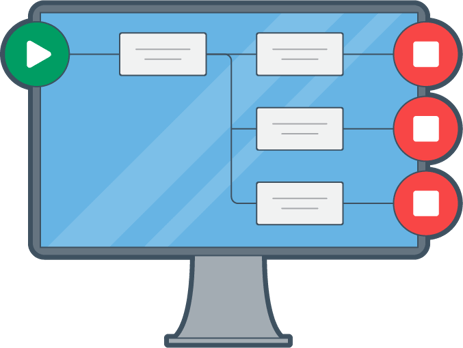EV Blog
Krista Lyons | May 28, 2020
15 Amazing Advantages of IT Self-Service Technology
IT self-service technology is becoming increasingly necessary for today’s remote work landscape. The move to shift-left and go lean has created a greater need for increased organization and communication, which are fundamental pieces of any successful IT service management strategy.
Challenges of IT Self-Service Technology
As with the introduction of any new tech, there are pros and cons of employee self-service technology. For example, one of the challenges of self-service technology lies in implementation itself. If employees are not properly trained on proper use or are not encouraged to use self-service before contacting a support agent, then the software and strategy behind it may be moot.
User language may present one of the additional challenges of self-service technology. For example, if a user is attempting to search for information regarding a software update, but they continually search with terms like “broken laptop,” the results yielded will be incorrect. This can be remedied with the use of Natural Language Processing, or NLP, which you can read more about here.
However, despite the challenges, there are several positive reasons to implement an employee IT self-service portal.
15 Amazing Benefits of IT Self-Service Technology
When weighing pros and cons of employee self-service, especially when considering a remote or blended workforce, it is important to note that the there are several positive benefits of self-service technology.
Here are the top 15 amazing benefits of IT self-service technology:
#1: Fewer Calls to the Service Desk
When employees are able to help themselves, the number of calls to the service desk can be dramatically reduced. In fact, IT self-service technology can reduce calls by as much as 30% (or more!).
#2: Higher ROI
The average cost-per-ticket for support teams ranges from $2.93 to $49.69, with the average ticket costing around $15.56 and the average cost per minute for handling a ticket at $1.60, according to a 2017 study from HDI. When the number of calls for Level 0-1 tickets is dramatically reduced, there is a much higher return on investment associated with those costs.
#3: Improved Employee Experience
Employees expect the same flexibility with problem-solving at work as they do at home. IT self- service technology allows employees to find answers quickly, making them more efficient, which studies show actually increases employee satisfaction. Providing an efficient IT Self-Service portal that enhances employee experience is also key for internal branding, employee churn, talent acquisition, and so much more.
#4: Simultaneous Accommodation of High Ticket Volume
IT self-service portals allow multiple users to access the portal at the same time, rather than waiting on hold for the same (potentially over-worked) service desk employee to answer their call. This means that more people can access information, answers, and get the help they need in a limited amount of time. In case of major incident that requires to put in place crisis management processes, the IT Self-Service Portal is a key communication channel to prevent high ticket volume.
#5: Simplified Ticket Creation and Tracking
An IT self-service portal allows users to create and track tickets on their own. This can result in not only fewer calls to the service desk to create the ticket, but fewer calls to track the ticket as well. Chatbots and virtual agents within the self-service portal can work to simplify the way users check for ticket status updates and track progress.
#6: Effortless Coordination for a Remote or Blended Workforce
No matter where employees are, IT self-service software can meet them there and help resolve tickets faster. This means that there is no longer a need for employees who work in different time zones to attempt to coordinate calls to the service desk. Rather, they are able to resolve their issue on their own schedule and can better coordinate with the service desk if collaboration is needed. Self-service also provides support for more languages and time-zones at a far-lower cost than employing native-language speakers.
#7: Simpler Processes
IT self-service allows for simpler, easier to follow processes overall. This means that new-hires and seasoned employees alike can follow a simple process to find answers and resolve their problems without lengthy procedures. This also results in a boost in productivity and overall reduction in cost.
#8: On-the-Go Capabilities with Mobile App Integration and Programmable Bots
Self-service portals can be integrated into mobile apps, making it easier to find answers and get help wherever you are. This is especially helpful with a remote or blended workforce with team members who may be working from mobile devices, iPads, or laptops. When combined with AI, like chatbots, finding help can be as simple as sending a text message.
#9: Uncomplicated Management
IT self-service software requires fewer resources to manage and more simplicity when managing a remote IT service desk team, freeing up leadership teams for higher level issues. Rather than having to push training to the service desk when an IT procedure changes, managers can simply update the knowledge management database and self-service portal.
#10: Decrease in Ticket Volume
According to HDI, a small percentage (10%) of organizations experienced a decrease in ticket volume in 2019. The top two factors cited by these organizations were self-help and knowledge management. While this may seem like a small percentage, there seems to be a correlation between the increase in self-help and a decrease in tickets.
#11: Easy to Update
Updating an IT self-service portal can be as easy as the push of a few buttons. Additionally, knowing which areas need to be updated can be simplified with smart analytics. These analytics can provide insight into which areas are still confusing for users, which areas require updates to the knowledge base, and which areas are working properly.

#12: Trackable Data and User Information
Just as a self-service portal offers helpful analytics and insights into what knowledge needs to be updated, it also sheds light on important data that you may otherwise be unable to track. For example, if employees in one department are continually seeking help with a particular program, it can be an alert to train that department on how to better use the software.
#13: Accessible Feedback
IT self-service software can help managers and leaders understand which efforts are working and which are not by asking for anonymous feedback via the self-service portal. This gives users the opportunity to provide honest feedback without fear of retaliation and gives better insight into processes or team members who need to make changes.
#14: Ability to Program the Human Touch
Self-service doesn’t mean the end of human interaction. Moreover, it means the beginning of more meaningful interactions. Although it seems like an oxymoron, it is not. With intelligent chatbots integrated with an IT self-service portal, users can have more effective communication by the time their ticket reaches a human.
#15: Eased Pressure on Overworked Service Desks
Taking employee contacts away from the telephone channel can have a significant effect, especially when issues and requests are self-solved by employees. This means that the overworked service desk can take a breather and focus on proactive projects rather than reactive patches.
Real Use Benefit of IT Self-Service Technology
An IT self-service portal can enhance an efficient service desk and can help teams who have fallen behind recover. These benefits far outweigh the challenges of implementing a self-service portal.
To learn more about IT self-service portals and to request a demo, click here!
Subscribe to Email Updates
Krista Lyons
Krista Lyons is the Content Marketing Manager at EasyVista and is dedicated to sharing helpful information and industry insights through EasyVista's website, social media, and communications. A graduate of the University of Tampa, Lyons has a background in journalism and communications. She enjoys all things tech and has a passion for reading and writing about artificial intelligence.




